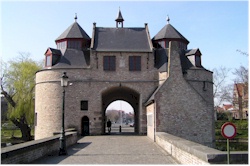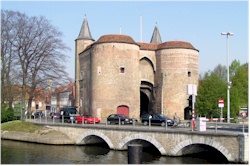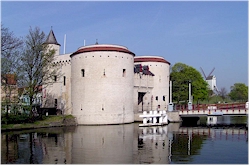|
Picture: Kruispoort with Bonne Chiere mill on the background . |
|
» Eating » Sleeping facilities » Going out in Bruges » Fixed events » Beguinage » Belfry and halls » Chapel of the Holy Blood » Court of the Princes » Dunes abbey » Guild houses of Bruges » Hospices of Bruges » Jerusalem church » Nation houses » Our Ladies church » Poortersloge » St-Anna's church » St-Donatian's cathedral » St-John's hospital » St-Saviour's cathedral » Town gates » Town hall » Windmills of Bruges » Complete overview... » Archeology museum » Brangwyn museum » Brewery museum » Chocolate museum » Diamant museum » Folklore museum » Frites museum » Groeninghe museum » Guido Gezelle museum » Halve Maan » Lace museum » Lamps museum » Memling museum » Museum of Fine Arts » Salvador Dali museum » St-Janshuismill » St-John's hospital » Complete overview... » Boterhuis » Boudewijn Seapark » Burg » Canals (Reien) » Coupure » De Garre » Grote Markt » Historium » Huidevettersplein » Jan Van Eyckplein » Lake of Love (Minnewater) » Rozenhoedkaai » Simon Stevinplein » 't Zand » Complete overview...
|
The town gates of Bruges Bruges' remaining four town gates were a part of the second defensive walls that were built at the end of the 13th century. After the defeat of the Flemish armies against the French crown (battle of the Pelevenberg), the French king in 1305 ordered that the gates had to be torn down so that the town would not be able to defend itself anymore (treaty of Athis-sur-Orge). However, in the course of the same century the defenses were rebuilt and continuously improved. The gates on the eastern side (the Kruispoort and the Gentpoort) were more robustly built than the ones on the western side because the eastern side was more vulnerable for attack from outside. In 1782, emperor Joseph II ordered that the town walls had to be sold (with the goal that they would be demolished), however, several gates were spared in Bruges.
Location: Ezelstraat (on the crossing of the Ezelstraat and the Gulden-Vlieslaan)
Sidestory: bailiff Pieter Lanchals governed Bruges in the name of emperor Maximilian of Austria untill his death in 1488. During an insurrection of the towns against Maximilian, he was captured and tried. Found guilty, he was condemned to death. His head was placed on a spike at the Gentpoort and his body burried in the church or Our Lady. Location: Gentpoortstraat (on the crossing of the Gentpoorstraat, Boninvest and Gentpoortvest)
Location: Langestraat 191 (on the crossing of Langestraat, Kruisvest and Kazernevest) Smedenpoort. This gate shows many similarities with another surviving gate: the Ezelpoort. They were both built in the same period (Smedenpoort in 1368). A new upper part was added to the gate in 1615. In 1944, the building was severely damaged by an explosion. In 1948 it received an intensive restoration. In 2009, the gate was brushed up and painted in ochre. It's name is derived from the Smedenstraat, which means street of the (black)smiths. Location: end of the Smedenstraat (on the crossing of the Smedenstraat and Buiten Boninvest) Dampoort. Althought the Dampoort doesn't exist anymore (demolished in 1871), it is worthwhile mentioning because it was the largest bulwark in medieval Bruges. The Dampoort was actually a complex of no less than three gates that were interconnected: the Speipoort, the Sint-Niklaaspoort and the Sint-Lenaartspoort. It was no surprise that this massive defensive stronghold was built here since this was the place where ships entered the town. The complex was not only of military importance but also had an important commercial role. A part of one of the round towers is the only visible remainder of this once impressive structure. Location: Sasplein
Picture 1: Ezelpoort |
» getting to Bruges » transport, tours, links,... » Assebroek » Bruges » Dudzele » Koolkerke » Kristus Koning » Lissewege » Male » Sint-Andries » Sint-Jozef » Sint-Kruis » Sint-Michiels » Sint-Pieters » Zeebruges » Zwankendamme
|
|
© xplorengo.com. Information is provided from the location and various sources, we do not hold any responsibility with regard to information provided by others. xplorengo is not a travel agency and does not promote or organize trips we therefore hold no responsibility with regard to third parties that promote their services via us. No information or pictures can be copied or distributed in any way without written permission of xplorengo.com. All pictures are made and copyrighted by Hendrik De Leyn unless mentioned otherwise [Contact information]. |


